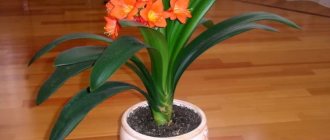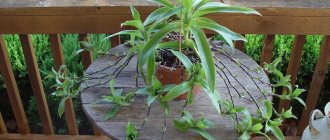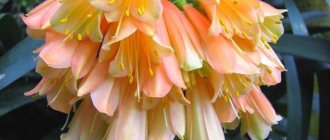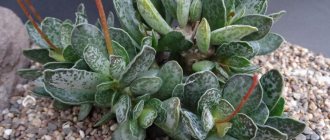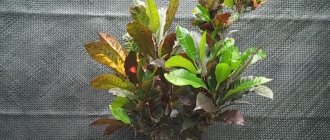Pachystachys is a perennial evergreen shrub of South American origin: its homeland is the tropical forests of Mexico and Peru.
In nature, the plant can reach truly gigantic sizes, stretching up to several meters in height and forming a powerful spreading crown. When kept indoors, pachistachis develops quite slowly, gaining about 8-13 cm in height per year. At home, without formative pruning, it can grow to approximately 120 cm in height.
Distinctive features of the shrub: thin, highly branched shoots, long, wide-oval leaves of a rich green hue and spectacular inflorescences-“ears” of golden yellow or bright red color.
| Slowly growing. In one season, the plant gains 10-13 cm in height. |
| Blooms in summer. Inflorescences that have bloomed should be removed. |
| The plant is easy to grow. |
| Perennial. |
Botanical description
Pachystachys is an evergreen shrub, a member of the Akataceae family, which is perennial. The distribution area of this plant is quite wide - it can be found in the tropical forests of Central and South America, on the east coast of Australia, and in Eastern India. Pachistachis usually reaches 1 meter in height , but some varieties grow up to 2 meters.
The shrub received its unusual name due to the shape of its flowers, which resemble a spike.
“Golden Spike” has straight shoots of medium thickness, topped with large oval leaves (about 10-12 cm in length), pointed towards the end.
The flowers of the plant are white and almost invisible. Pachistachis blooms for 10-12 days , after which the flowers fall off, but the bracts still remain.
The plant is notable for its inflorescences, formed from several bracts of bright yellow or orange color. Each bush produces 15-20 inflorescences; the bracts are pleasing to the eye from March to October.
Useful properties of pachistachis
Since Pachistachis is poisonous, the value of this plant for gardeners lies solely in its aesthetic qualities. A lush pachistachis bush, crowned with unusual inflorescences, can decorate not only an apartment or house, but will also look organic in classrooms, offices, libraries and other public places.
Varieties and photos
There are approximately 12 varieties of Pachistachis, of which only two are suitable for indoor growing. Below are photos, names and descriptions of pachistachis varieties suitable for propagation and care at home:
Yellow
This variety is distinguished by yellow spikelets and is the most popular among gardeners. Pachistachis yellow has straight stems, which become woody as the shrub grows. The leaves of the plant are large - up to 5 cm wide and 15 cm . in length. You can see what the Pakhistachis Yellow variety looks like in the photo below:
Red
Unlike the previous variety, the flowers of the shrub do not hide among the inflorescences, but rush upward in the form of red panicles. This variety is also notable for its larger size. Pachistachis red grows up to 2 meters in height and requires a lot of space. The bracts are greenish in color and the red flowers stand out against the green foliage. In the photo below is the variety Pakhistachis Red:
Conditions for flowering
There are certain requirements that contribute to the formation of inflorescences, here are some of them:
- sufficient lighting;
- in the summer season - creating shading for the plant;
- moderate watering and timely fertilizing with organic and mineral fertilizers;
- in winter, watering is replaced by spraying;
- regular transplant.
For pachystachys, transplantation is necessary to stimulate growth, but it should be borne in mind that this procedure is quite traumatic and requires care. One wrong move and the flower will stop blooming.
Care
“Golden Ear” is accustomed to tropical growing conditions, so the main task of the grower is to create an optimal environment for the healthy growth of the exotic shrub. We'll talk further about how to properly care for pachistachis.
Lighting
“Golden Shrimp” will need a lot of light, but remember the main rule: when placing the bush on a south window, create light partial shade , otherwise bright rays will damage the leaves and the flower will die. In winter, take care of additional lighting.
Temperature
This plant will need an average temperature of 20-24 degrees in the spring-summer period and 16-19 degrees with the onset of cold weather. A mark of 14 degrees will already be critical for the flower and threatens its death.
Avoid drafts in the room, and do not place shrubs close to radiators.
Humidity and watering
Pachistachis loves high humidity - this applies to both the soil in the pot and the air in the room where the plant is kept.
On warm, sunny days, watering should be plentiful and regular; do not allow the earthen ball in the flowerpot to dry out. In the autumn-winter period, the flower should be watered as the top layer of soil dries.
Sometimes add an infusion of onion peels or ash to the water for irrigation - this will have a beneficial effect on the health of the bush. Use only settled water at room temperature.
Spraying in the summer should also be regular; if there is a lack of moisture in the air, place a vessel with water next to the plant or place the pot on a tray with wet peat or pebbles.
Top dressing
During the period of intensive growth, the shrub will need help in the form of fertilizers. The frequency of feeding is from April to October.
The following remedies will have a beneficial effect on pachistachis:
- "Universal";
- "Aquarin";
- "Bioton";
- "Living Force";
- "Agricola".
They should be applied no more than once every two weeks.
Transfer
Transplantation is carried out before flowering begins, in early spring. The frequency of replanting depends on the intensity of shrub growth. So, adult flowers are replanted once every 3 years .
The soil for replanting is prepared in advance. It should be disinfected within two weeks by watering it with a solution of potassium permanganate or heating it in the oven.
The procedure is as follows:
- before transplanting, we prune the flower, removing excess shoots and dried leaves;
- Cover the bottom of the pot with a drainage layer;
- transfer the plant from the old pot to a new place;
- pour the soil mixture into the pot, filling all the voids and compact it thoroughly;
- We water the transplanted bush and keep it away from bright rays during the adaptation period.
Priming
We cover the bottom of the pot with expanded clay or pebbles, after which we add the substrate. The recommended soil composition should contain several components taken in equal proportions:
- leaf soil;
- peat;
- turf;
- humus;
- river sand (coarse-grained).
If you do not want to prepare the soil mixture yourself, purchase ready-made soil for beautifully flowering ornamental plants.
What soil do you prefer to use?
PurchasedI make my own
The thickness of the drainage layer should not be less than 3 cm.
Trimming
If there is no pruning, the bush will stretch out, lose its splendor, and flowering will be sparse.
Therefore, pruning of adult plants should be done every spring. Young bushes are pruned when the shoots reach 10-15 cm in height - then they should be pinched or cut.
Peduncles of this plant appear only on young shoots , and flowering begins only in the third year of life.
Further pinching should be done every spring. To do this, we retreat from the top of the flower by 2 pairs of leaves and pinch them off. This way you will get a beautifully shaped bush that will delight the eye with its lush foliage and abundant flowering.
By winter, when Pachistachis stops blooming, it is necessary to cut off its bracts - they are cut off along with a pair of leaves located below. This pruning method will help achieve branching and rejuvenate the bush.
Pruning rules
It is regular pruning of pachistachis that helps to form a beautiful bush and stimulate the process of abundant flowering. If we talk about pruning rules, experienced flower growers note the following basic principles:
- The very first pruning is carried out when the plant reaches about 15-20 cm.
- On each tier of shoots developing from the lateral buds, only the third pair of leaves is pinched.
- In the first year, at least 3 such procedures are performed to form a full-fledged bush, and by winter you will receive a plant with 10-12 fully developed tops. The next year they are also pinched - as a result, you get from 16 to 24 full-fledged branches and so on.
- Pruning is carried out exclusively before the plant blooms, and the pinching procedure is carried out only after the plant has flowered.
- Trim the plant at the root in winter, leaving 3 pairs of leaves.
Reproduction
To get new plants, you need to know the possible methods of propagation. "Golden Ear" propagates by cuttings and seeds. We'll talk about each method further.
Cuttings
Cuttings are harvested immediately after flowering. To do this, take cuttings that have at least 2 leaves . Followed by:
- Place the cuttings in a container filled with a growth stimulator (you can take “Kornevin”), and then plant them in the prepared substrate.
- Cover the cuttings with a jar or plastic and place them in a well-lit place.
- When young shoots form, remove the jar. At this time, the lower leaves will die off.
After 15-20 days you will be able to see the first flowers.
Note that propagating shrubs using cuttings is the most popular method, because the result will not take long to wait.
Seeds
Planting seeds occurs with the arrival of spring and consists of several stages:
- Prepare the substrate for planting in advance. To do this, take a medium-sized container. Be sure to moisten the soil.
- Sow the seeds evenly and cover future plants with film to create a “greenhouse” effect.
- As the substrate dries, carefully spray the seedlings. In addition, regular ventilation is necessary.
- As soon as the shoots appear, remove the film.
- When the first leaves appear, plant the bushes in separate containers.
Watering
In spring and summer, watering pachistachis should be plentiful - once every 3-4 days. Between moistenings, the top layer of soil should dry out slightly. Starting in autumn, the frequency of watering is gradually reduced.
In winter, the soil is moistened once every 10-14 days, 1-2 days after the top layer has dried.
Pachistachis is very sensitive to changes in watering regime . Therefore, you should avoid both waterlogging and drying out of the soil.
Soft water at room temperature, without lime and chlorine, should be used for irrigation.
Diseases and pests
Mature shrubs, as a rule, are not prone to disease. The main problems arise from improper care. Let's talk in more detail about how to act in each situation.
Why do the leaves curl?
Curling and falling leaves can most often be seen during the cold season. The main reason is uncomfortable living conditions. Most often these are drafts, as well as temperature changes .
The second reason is too much water in the soil.
Do not forget to drain excess water from the pan, do not allow moisture to stagnate in the roots - it can have a detrimental effect on the well-being of the flower.
Why doesn't it bloom?
It also happens that the bush does not form flower stalks. This is due to two factors:
- lack of spring pruning;
- the plant does not have enough light.
Getting a healthy, flowering shrub is not difficult - it is only important to eliminate the listed reasons in time and pay maximum attention to the flower.
Leaves turn yellow and fall off
Yellowing and subsequent falling of the foliage indicates non-compliance with the recommended temperature regime .
Remember that too high a temperature leads to plant diseases. In winter it should not rise above 16-18 degrees. A pot with a plant can be placed on a closed loggia.
The leaves turn pale and wither
This condition is due to three reasons:
- Excess sunlight.
- Rare watering.
- Lack of nutrients in the soil.
The bush stretches out
When the stem of a bush grows strongly and it loses its beauty, take care of proper lighting . Move the pot to a brighter place, and then use pinches to give the flower the desired shape.
During this period, the plant will need abundant watering.
Temperature
Pachistachis will feel comfortable in spring and summer at 20-23 degrees. At higher temperatures, it is important to ensure high air humidity. In winter, the optimal temperature is 16-19 degrees, but not lower than 14.
It is recommended to regularly ventilate the room in which the pachistachis is located. However, it should be protected from cold drafts, as well as from warm air currents.
If the winter is colder or the summer is very hot, the leaves of the plant may fall off and the shoots may become bare. It is better to place the flower away from heating appliances.
The plant develops well even without a cool winter. Keeping it all year round at room temperature 20-25°C can only affect its flowering - it becomes less abundant and long-lasting.
The higher the temperature of the winter content of Pachistachis, the more intensively it grows during this period. Therefore, when natural light becomes insufficient, it is recommended to lengthen the daylight hours, including artificial lighting.
Signs and superstitions
There are several signs associated with growing the “golden shrimp”:
- The purchase of a healthy flower will provide a new outbreak of feelings in the family, but it needs a return. The plant may lose its properties if there is betrayal in the family.
- Pachistachis provides powerful support in the home even though it does not have protective properties.
- The flower helps get rid of sudden mood swings and is especially important for choleric people.
- If the leaves of a flower are curled, there may be financial problems in the house, so pay great attention to air humidification and pest prevention.
- Abundant flowering portends a happy event.
- When the “golden shrimp” loses its flowers and the leaves of the plant dry out and fall off, expect bad news from loved ones.
Pachistachis is not picky about growing conditions and does not require special care at home, but its basic preferences should be taken into account. The plant will delight conscientious owners with unusual, bright flowers.
A little history
This unusual plant came to Europe, and then to Russia, from India. In addition, the flower grows in the American tropics and Peru. In the wild, the length of shoots can reach more than 2 meters, but in home growing conditions it is difficult to find a plant more than half a meter.
Beautiful indoor plant
The first specimens of this ornamental bush appeared in the collections of botanists and in the greenhouses of rich salons back in the mid-19th century. Then interest in this plant gave way to long oblivion. And only in the middle of the 20th century, pachistachis again appeared on the windowsills of apartments and in the garden plots of private houses.
Pachistachis yellow
Transfer
Now let's study how to transplant pachistachis.
Pachistachis should be replanted in the spring. For young specimens, this procedure is carried out annually, and for adults – once every 2-3 years.
The plant prefers wide but shallow containers. The new pot should be 2-4 cm larger in diameter than the previous one.
It is optimal to combine replanting with pinching shoots . This formation of the crown will allow you to grow a lush ornamental bush.
The root system of pachystachys grows quickly, especially in the first year of its life. If the plant's roots have grown out through the drainage holes, it needs replanting. Young specimens sometimes have to be replanted twice a year - in spring and autumn.
In order not to injure the roots, an absolutely healthy flower is replanted using the transshipment method. It is recommended to replant a diseased plant with revision of the root system and complete replacement of the soil. When replanting, it is necessary to provide good drainage to remove excess moisture from the soil.
Humidity
Pachistachis prefers fairly high air humidity - not lower than 55%.
To ensure favorable conditions, it is recommended to place the plant in a tray filled with damp sphagnum moss or expanded clay.
It would be a good idea to place containers of water around the flower. If possible, it is advisable to use a humidifier.
Pachistachis needs spraying all year round. Spraying is carried out once a day - in the morning or evening . However, on hot summer days, as well as in rooms with dry air, two-time spraying is recommended.
The procedure requires a fine-grained spray bottle and warm, settled water.
The soil
The soil for planting pachistachis should be nutritious, slightly acidic, and well-permeable to moisture and air. Any slightly acidic substrate for flowering indoor plants purchased at the store will do. You can prepare the composition yourself by mixing the following components:
- Sod land - 2 parts;
- Peat – 1 part;
- Humus – 1 part;
- Sand – 1 part;
- Leaf soil - 1 part.
You can add a little crushed pine bark to the mixture to loosen and oxidize the soil. It is important not to forget about a good drainage layer.


